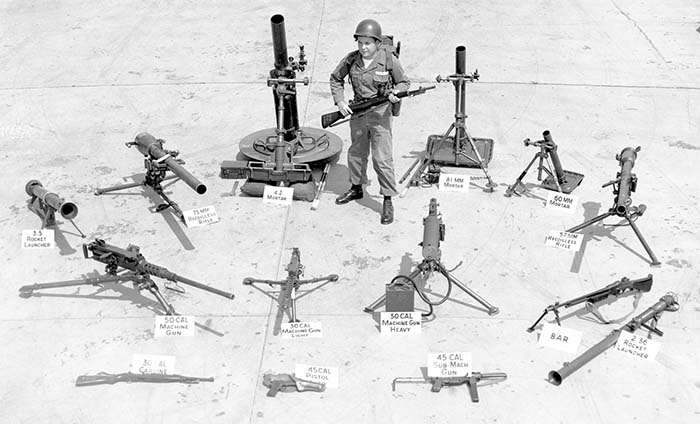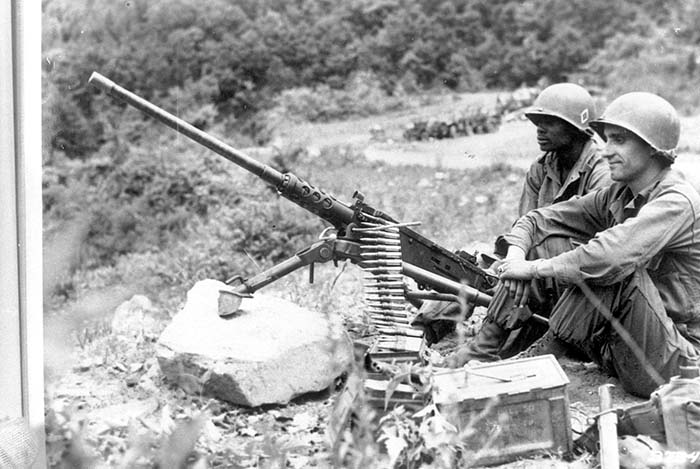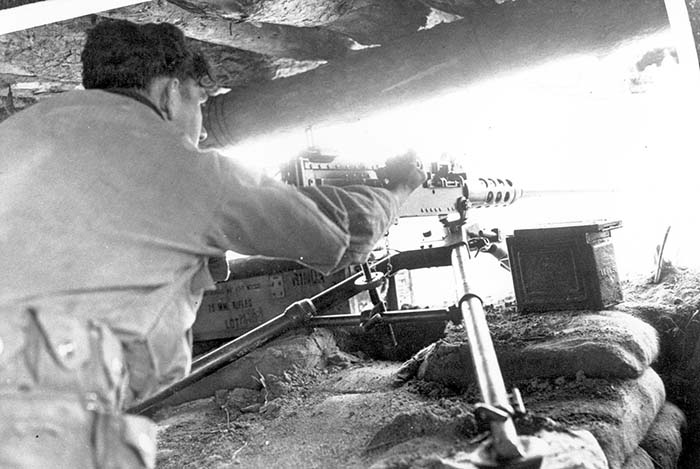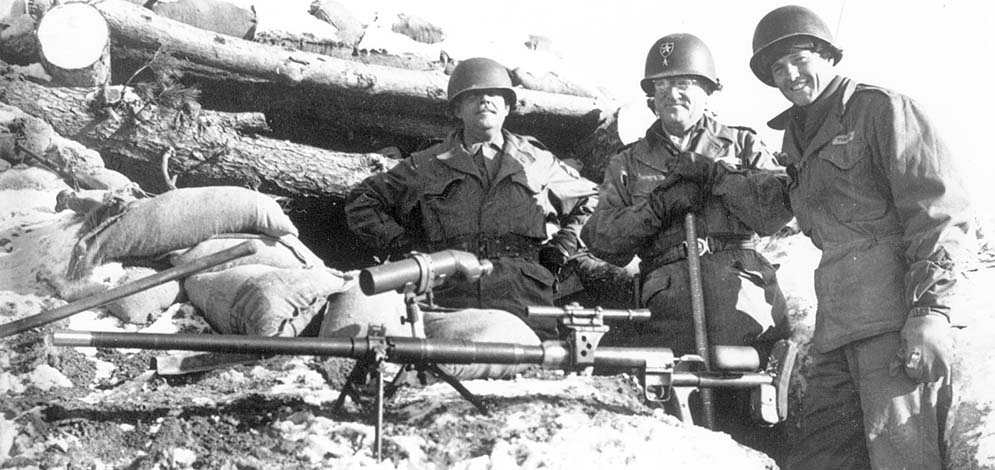Lead Photo: Fall, 1951, Korea. A crewman reloads a belt of ammo onto a 200 round capacity M2 ammunition chest for an M2HB .50 caliber machine gun, one of four installed in a motorized M45 mount. This “Quad Fifty,” riding on an armored halftrack, is providing fire support to 9th Infantry Division troops during operations around Hill 983, better known as “Bloody Ridge.” A combined rate of fire in excess of 2000 rpm and effective reach of much more than 2000yards makes the quad fifty a fearsome weapon against enemy troop concentrations. Credit: SC/NA/RB
By Robert Bruce
“Though the .50 caliber figures little in the hilltop fighting, it has paid its way in Korea, particularly in defense against infiltration of ground rearward of the infantry main line. Close defense of the artillery gun positions could hardly hold together without this weapon.” Operations Research Office Report R-13, Oct 1951
First introduced into the US military inventory in the 1920’s, John M. Browning’s .50 caliber M2 Heavy Barrel machine gun is still the best in its class. Indeed, “Ma Deuce,” as she has been affectionately called by GI’s for more than seventy years, is still on active duty today. During the Korean War, the powerful M2 HB proved versatile and lethal not only as a single weapon, but particularly so in multiple mounts.
Bigger is Better
While the .30 caliber Brownings were relatively light, portable and effective in combat when properly maintained and utilized in tactically sound roles, their range and hitting power were often inadequate. Faced with well dug in enemy defenses at ranges in excess of 800 to 1000 yards, the rifle cartridges fired by these smaller machine guns fell short in reach and penetration. Fortunately, an excellent solution to the problem was readily available.

The .50 caliber M2 HB can be considered a beefed up version of the Browning M1917 and 1919 guns, sharing many of their mechanical characteristics and combat proven as a star performer in WWII. Although setting of its headspace and timing could be a bit tricky to the uninitiated, the big beautiful Browning earned a reputation for reliability and lethality in ground, air and seaborne operations under the worst conditions.
Plenty of M2s were on hand with Army and Marine units at the outbreak of the Korean War. Of course, each infantry battalion had tripod mounted “Fifties”in headquarters and heavy weapons sections, and this was also the case in artillery, engineer and other combat or combat support formations. These heavy machine guns were a mainstay of perimeter defense as well as giving significant protection against low flying enemy aircraft.
“With the .50 which I was operating, and with an LMG (light machine gun) which PFC Lloyd A. Perry was firing from right next to me, we put up the covering fire which enabled the (artillery) battery to hit the road. As the position was laid out, the guns had to come from my left and turn around the .50 to get on the road…they were a pretty well exposed target. But the .50 and the LMG, together spraying the area ahead of us, kept the enemy fire pretty well dampered.” Sgt. William F. Aragon, 8th Field Artillery Battalion, quoted in ORO-R-13.
Ammunition Options
The exceptional performance of the M2 HB’s ammunition, impressively measuring some 5.45 inches long and weighing a hefty 1800 grains or more, deserves comment. Even ordinary ball cartridges, also designated M2, have a muzzle velocity of about 2930 feet per second and range in excess of 7000 meters. Penetration of the 709 grain gilding metal covered lead-antimony slug at all ranges is also a dramatic leap beyond that of .30 caliber bullets. At 600 meters, for example, the M2 ball would chew through a foot of dry sand and more than two feet of clay, ruining the day for North Korean and ChiCom soldiers even when they are hunkered down in bunkers.

Other types of ammunition are available for special situations such as dealing with lightly armored vehicles. The M2AP cartridge, with its manganese-molybdenum steel penetrator, will punch through a half inch of face hardened steel plate at 600 meters. Then, combined with an incendiary element to light up what’s behind that armor, the M8 API round can be particularly nasty at any range. Tracer fillers to assist fire control are also available in various combinations. The most common at the time was the Tracer, M1, which lights up at about 250 yards and continues to burn out to some 1700 yards.

.50 Caliber Sniping
Although Korea’s abundance of seemingly endless parallel ridgelines was a limiting factor in “by the book” tactical employment of many infantry and support weapons, this terrain feature also prompted a revival in the science and art of long range marksmanship. It is readily understandable why, when the enemy is dug into or advancing along a hillside right across from your position with only air in between, GIs would experience the natural desire to “reach out and touch him.” This was done at moderate ranges with accurized and scoped versions of the ’03 and M1 rifles, but something more was needed when the distance got well 600 or 800 yards.
The 84 pound M2 HB machinegun on its sturdy 44 pound tripod with precision traversing and elevating mechanism is a very stable shooting platform – sort of a self-contained bench rest setup. In addition, its massive “bull barrel” is inherently accurate and 45 inch length helps develop maximum velocity for the bullet. Luckily, performance of the M2 .50 caliber ball cartridge was pretty good despite being mass produced in the tens of millions. Army specs called for “…average of the mean radii of all targets at time of acceptance at 600 yards is not greater than 9 inches.”
Then, since the gun fires from a locked breech and can be operated in single shot mode, it compares favorably with bolt action rifles. “Ma Deuce’s” conversion from workhorse machine gun to sniper weapon is completed with addition of a telescopic sight, and she found gainful employment in numerous observation posts all along the battlefront.
Quad Fifties
M2HBs were also found on tank turrets, truck ring mounts and on other vehicles; notably the halftrack-mounted “Quad Fifty.” Fielded in WWII for both antiaircraft and ground support roles, the Multiple Gun Motor Carriage M16 had four heavy Brownings in a power operated M45 Maxson Mount piggyback on an M3 halftrack.

“…it is an adjunct of infantry fighting that the AA (anti-aircraft) gun has had its most decisive impact upon Eighth Army operations. This is particularly true of the quad-50 (M16). Which has a greater tactical flexibility in ground fighting and a visibly greater demoralizing effect upon the enemy infantry line than the Bofors twin-40. It would be difficult to exaggerate the effectiveness of the quad-50 when used in this role.” ORO-R-13
The M16 system was a good combination of mobility and firepower, able to travel quickly to places it was needed and immediately relocate within an operational area in response to the direction and intensity of enemy actions. The total rate of fire for all four M2s in this system is an awesome 2000 rounds per minute with an effective range approaching 2000 yards. Enemy MIG fighter jets knew better than to make close strafing attacks where Quad Fifties were on the job.
This combo served particularly well in supporting infantry attacks by saturating enemy defensive positions with a hail of steel, severely limiting their ability to resist. In defense of American positions against Communist assaults, a Quad Fifty could drive to the best location needed to repel the spearhead of an enemy assault. Armored sides on the halftrack and a protective shield on the gunner’s station were impervious to rifle caliber small arms fire.
Primary References
FM23-65 and TM 9-1005-213-10 Brig. Gen. S.L.A. Marshall, “Commentary on Infantry Operations and Weapons Usage in Korea; Winter of 1950-51,” Johns Hopkins University, Operations Research Office Report ORO-R-13, Oct 27, 1951
Terry Gander, “The Browning M2 Heavy Machine Gun,” PRC Publishing, Ltd., 1999
| This article first appeared in Small Arms Review V4N12 (September 2001) |











